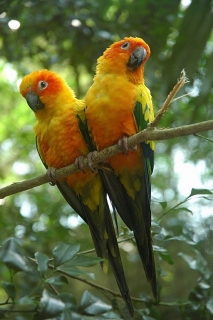Sun Conure |
|
|
Also known as: Yellow Conure, Sun Parakeet
Photos
View in GalleryDid You Know?
The Sun Conure was recently uplisted to Endangered due to a very rapid reduction in its population size during the last three decades.Programs & Projects
WPT has worked with numerous partners to help save this species. Learn moreAcademic Research
Related publications: Aratinga solstitialisSpecies Profile
Genus: Aratinga | Species: solstitialis
Size:
30cm (11.7 in)
Weight:
120-130g (4.2-4.5 oz)
Subspecies including nominate:
one
Colour Adult:
Both adults in general deep yellow with varying orange tints on forehead, sides of head, lower abdomen, rump and lower back; green undertail coverts tinted with yellow; yellow mantle, lesser and middle upperwing coverts and underwing coverts; dull grey underneath flight feathers; green secondary coverts with wide yellow tips; dark blue primary coverts and outer webs of flight feathers; upper tail olive, undertail olive/grey. Bill grey/black. Eye ring bare and grey/white. Eye dark brown.
Colour Juvenile:
Green on crown; green upper back and scapulars with slight yellow edges; rump and lower back has red tint; green uppertail coverts with yellow tint; green throat; orange breast and abdomen; green undertail coverts margined with pale green; green lesser and middle upperwing coverts edged with yellow. Bill paler grey. Eye ring and cere bare and white.
Call:
Calls made in flight are screechy and rapidly repeated in short notes. While perched emits chuckling and thin, high-pitched wheezy notes.
Listen NowVideo Links:
Video 1 | Video 2 | Video 3More Information:
Content Sources:
CITES
BirdLife International
Cornell Lab of Ornithology/Birds of the World
Parrots: A Guide to Parrots of the World, Juniper and Parr, 1998
ML Media Collection Catalogue 117046, Sun Parakeet Aratinga solstitialis, Marantz, Curtis, Para, Brazil, Jan. 11 1997, Cornell Lab of Ornithology. Site
Parrots of the World, Forshaw and Cooper, 1977. 2010 edition
Vanished and Vanishing Parrots, Forshaw, 2017.
Parrots of the World, Forshaw, 2006.
Parrots in Aviculture, Low, 1992.
Psittacine Aviculture, Schubot, Clubb and Clubb, 1992.
A Guide to Incubation and Handraising Parrots, Digney, 1998.
Photos
View in GalleryDid You Know?
The Sun Conure was recently uplisted to Endangered due to a very rapid reduction in its population size during the last three decades.Programs & Projects
WPT has worked with numerous partners to help save this species. Learn moreAcademic Research
Related publications: Aratinga solstitialisSpecies Care
Captive Status:
Fairly common
Longevity:
30 yrs
Housing:
Aviary or suspended enclosure, minimum length 2-3m (6.5-9.8 ft).
Diet:
Fruit such as: apple, pear, orange, banana, pomegranate, cactus fruits; vegetables such as: carrot, celery, green beans and peas in the pod; fresh corn; green leaves such as: Swiss chard, lettuce, sowthistle, chickweed; spray millet; small seed mix such as: canary, millet and smaller amounts of oats, buckwheat and safflower; soaked and sprouted sunflower seed; cooked beans or pulses, boiled maize, and complete kibble.
Enrichment:
Socialization. Also enjoys bathing, so provide overhead misters or shallow water bowls. Provide bird-safe wood and vegetable tanned leather chew toys, non-toxic hard plastic toys, puzzle toys, foraging toys, ladders, swings and different sized perches.
Nest Box Size:
Vertical box 12" x 12" x 18" (30.5cm x 30.5cm x 46cm).
Clutch Size:
3-4
Incubation Time:
24-25 days
Fledging Age:
7-8 weeks
Hatch Weight:
6g (0.2 oz)
Peak Weight:
117-120g (4.1-4.2 oz)
Weaning Weight:
110-115g (3.8-4 oz)
Photos
View in GalleryDid You Know?
The Sun Conure was recently uplisted to Endangered due to a very rapid reduction in its population size during the last three decades.Programs & Projects
WPT has worked with numerous partners to help save this species. Learn moreAcademic Research
Related publications: Aratinga solstitialisSpecies Wild Status
World Population:
Likely fewer than 2000.
IUCN Red List Status:
Endangered
CITES Listing:
Appendix II
Threat Summary:
The species has been exported from Guyana in large numbers, leading to its almost complete disappearance from that country. Capture for trade is ongoing; owing to the scarcity of these parrots in Guyana trappers have travelled into Brazil, where 90% of the population is thought to exist, to buy birds for export.
Range:
Restricted to N Roroaima in far NE Brazil and C and S Guyana east to the Kabalebo River in W Suriname. NW Surinam and SE Venezuela.
Habitat:
Birds are found in open savanna, savanna woodland, forested valleys and secondary growth forest.
Wild Diet:
Feeds on fruit, berries, nuts, buds and flowers; also legume pods, red cacti fruits and Malpighia berries.
Ecology and Behaviour:
Found in flocks of around 30 individuals. Seen in larger groups where fruit is abdundant. In flight are noisy, but remarkably inconspicuous while feeding.
Clutch and Egg Size:
3-4 rounded eggs, 29.5 x 23.5mm (1.1 x 0.8 in).
Breeding Season:
One report of a nest found in a Mauritia flexuosa palm in N Roraima in November.
Related Links:
Photos
View in GalleryDid You Know?
The Sun Conure was recently uplisted to Endangered due to a very rapid reduction in its population size during the last three decades.Programs & Projects
WPT has worked with numerous partners to help save this species. Learn moreAcademic Research
Related publications: Aratinga solstitialisMembers Only Resources
Please log-in now to find more research, resources and tools.
Not a Member?
Find more great information:
Gain exclusive access to 600+ pages of additional research, seminars and podcasts, specialists to ask your toughest questions, and dozens of other fun resources - when you become a WPT member.
Join Today >>

































